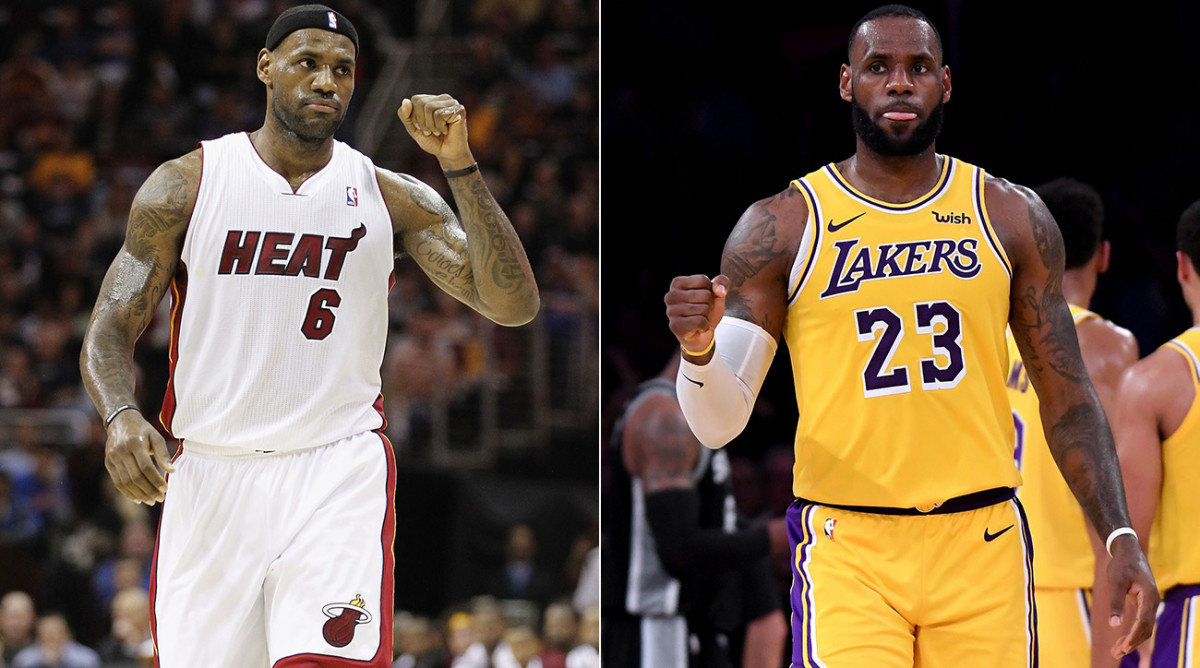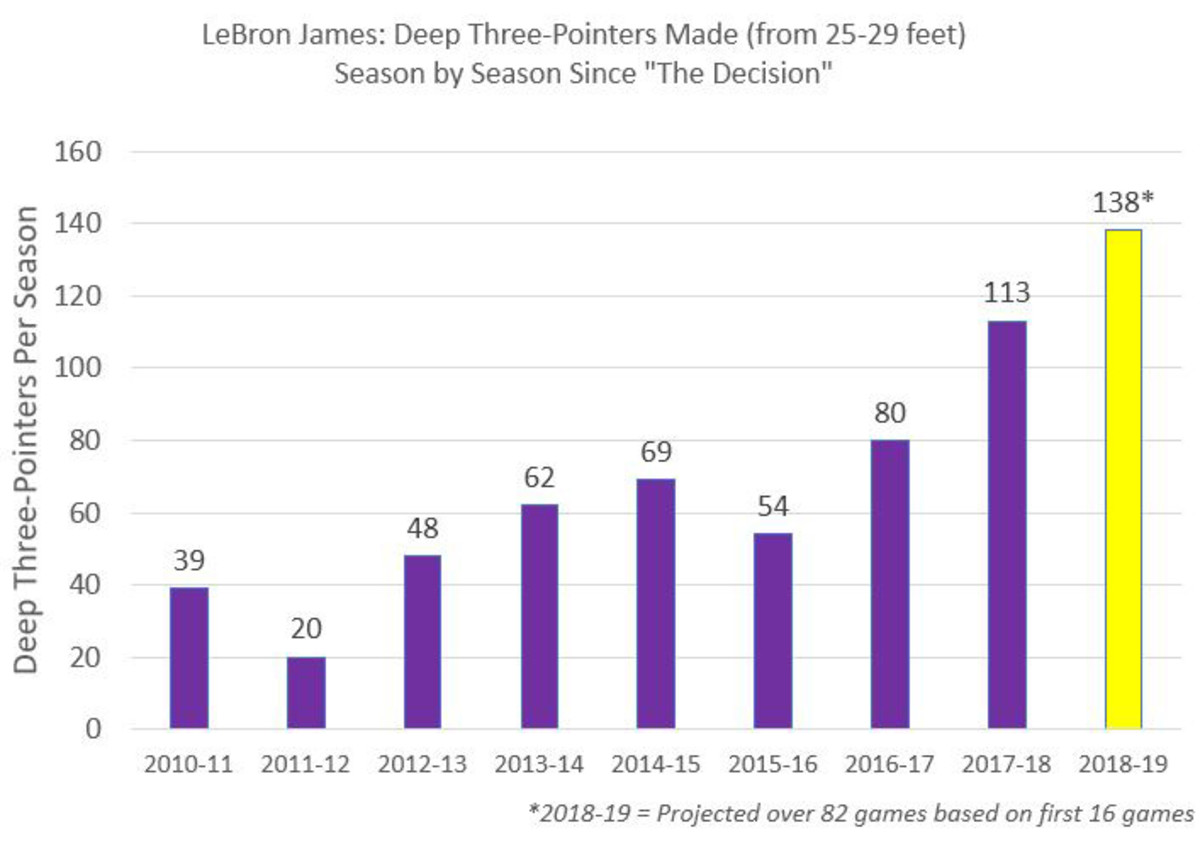LeBron's Return to Cleveland Feels Familiar—Until You Look Deeper

LeBron James and the newly-minted Heatles strolled into Cleveland on Dec. 2, 2010, greeted by bloodthirsty boos, chants of “Scott-ie Pipp-en!” and cutting signs that were clearly months in the making. Traitors don’t leave legacies. The Decision: Stay or Betray. What should you do? Beg for mercy. Who needs LeBron if you’ve got Bieber fever?
The ensuing game—James’s first in Cleveland since leaving for Miami that July—begged for an apology that was never going to come. Despite the messy surroundings, James played brilliantly and unflinchingly, throwing up his signature chalk toss before pouring in a game-high 38 points, eight rebounds and five assists. He wouldn’t win his first championship for another 18 months, but it was already clear that he was playing for a better team and charting a grander trajectory. The Heat throttled the Cavaliers 118-90, and James was only needed for 30 minutes in the blowout. Afterwards, TNT’s Craig Sager sought closure and compassion on behalf of a wounded Quicken Loans Arena.
“I don’t want to apologize,” James replied. “My intentions were not to hurt anyone. My intentions were solely on kids during the whole process. Decisions I make, I live with them. There are always ways you can correct them and do them better. But at the end of the day, I live with them.”
On Wednesday, James will make another highly-anticipated return to Cleveland. If one were painting with only the broadest of strokes, it might seem like history was repeating itself. As in 2010, his summer decision to leave the Cavaliers immediately refashioned the NBA’s competitive landscape. As in 2010, he trots into town with a glitzy, warm-weather, TV-friendly franchise on the upswing. As in 2010, the Cavaliers organization he left behind has looked hopeless. As in 2010, James is a leading MVP candidate, with 2018-19 numbers (28.8 PPG, 7.7 RPG, 6.9 APG) that are virtually identical to his 2010-11 numbers (26.7 PPG, 7.5 RPG, 7 APG).
Drill down, however, and it’s clear that the many differences that exist between 2010 and 2018 are more revealing than those similarities. For starters, the boos won’t be as loud or as long, and no one will be demanding an apology this time around. If The Decision was a case of good intentions gone horribly wrong, as James suggested, The Decision III produced no such emotional turbulence.

The biggest difference, of course, is that the Cavaliers’ improbable 2016 title inoculated James against legacy attacks. “The guy who couldn’t win in Cleveland" and “The guy who needed a Superteam to win in Miami” became “The guy who carried his local team to a Curse-snapping championship in Hallmark movie fashion.” As James lifted the Cavaliers out of the 3-1 grave, he buried the Benedict Arnold barbs and Scottie Pippen digs, replacing them with a lifetime of Michael Jordan comparisons. Even Cavaliers owner Dan Gilbert, who bid adieu to James with a caustic letter in 2010, opted for a congratulatory press release and a pledge to retire James’s jersey this time around.
The “kids” that James cited in his interview with Sager are a good prism through which to view James’s increased attentiveness and sophistication. In 2010, he was accused of using children as “props” after he announced his move to Miami in front of a crowd of elementary schoolers at a random Boys & Girls Club. This time around, he spent years methodically financing a foundation that helped bankroll the brand-new “I Promise School” in Akron, a tangible and substantial long-term commitment to at-risk youth in his hometown.
There’s plenty to be said about how much the sport has turned over. Twenty-two other players took the court during James’s first return to Cleveland, and 21 are no longer playing in the NBA. James Jones, Juwan Howard and Mo Williams have transitioned to front office and coaching jobs. J.J. Hickson has kept his career going in China and Lebanon. Daniel Gibson has launched a rap career and appeared on a VH1 reality show. Zydrunas Ilgauskas has already had his jersey number retired by the Cavaliers. Dwyane Wade is the last man standing, and even he has spent a good chunk of his “Last Dance” season away from the court on paternity leave. And then there’s Steve Kerr, who marveled at James’s layups as a TNT color commentator in 2010—years before he guided the Warriors to three titles against the Cavaliers.
Meanwhile, James continues to lord over the competition, overwhelming and outthinking this generation like he did the previous generation. His impeccable health and remarkable consistency have been crucial factors, but so has his willingness to evolve his game through multiple iterations. With Chris Bosh in Miami, he learned the value of a spread four and a high-pressure defensive scheme. During his second Cleveland tenure, he got comfortable leading a devastating offensive approach that prioritized threes and often surrounded him with four shooters. Now in L.A., he is playing at a breakneck speed while logging minutes at the four and even the five.
As the NBA has plunged deeper into pace-and-space, James has proven especially resilient and resourceful. Wade, never known as a shooter, hasn’t been a star in years. Carmelo Anthony, lax defender and lover of tough twos, has gone extinct. While Chris Paul remains an elite talent, he has been surpassed by Stephen Curry as the best player at his position and has accepted life as a second fiddle in Houston. Yet James, the oldest member of the 2018 All-NBA teams, has somehow remained thoroughly modern as his 34th birthday approaches.
His latest reinvention was on full display Sunday night, when he torched the Heat for a season-high 51 points. Although his night-to-night and play-to-play defensive intensity has waned in recent years, his shooting prowess has markedly improved. Against Miami, he hit six of his eight three-point attempts, including three of five from beyond 25 feet. Through 16 games, he’s on pace for new career-highs for three-point makes and attempts per game.
In 2010-11, less than one out of five of James’s shot attempts came from beyond the arc. Now, nearly one in three do. What’s more, James continues to demonstrate a Curry-like willingness to trust his range well outside the arc. The career 34.5% three-point shooter now casually steps into multiple 25+ foot bombs on a nightly basis.

As with Curry and other long-ball practitioners, James’s deeper comfort zone creates more opportunities for him to drive past extended defenses and to create higher-efficiency shots for his teammates, whether they be JaVale McGee lobs or clean catch-and-shoot threes. The Lakers’ offensive efficiency has improved from No. 22 last year to No. 9 this year and their collective three-point percentage has jumped from No. 29 to No. 11. James has his fingerprints all over those improvements, ranking No. 10 in the NBA in touches and No. 6 in the NBA with 256 points created by his assists.
L.A.’s winning record and humming offense amount to only half the story when it comes to demonstrating James's current impact. The Cavaliers have already fired their coach, fallen from No. 5 in offensive efficiency last year to No. 26 this year, and claimed the league’s worst record. While Tristan Thompson declared in September that the East still runs through Cleveland, there’s a decent chance the Cavaliers will be the first team eliminated from playoff contention. Plop James back in the Q, and Cleveland’s floor is probably the Eastern Conference finals.
Cavaliers: Record since The Decision I, 2010-11 to present
• With LeBron James playing: 207-94 (.688) | 56-win pace
• Without LeBron James playing: 103-251 (.291) | 24-win pace
Wednesday, then, will serve as a milepost on James’s path towards what could be his fifth MVP award—a side-by-side analysis of his value when present and absent. The Lakers aren’t great or overly talented, but they’re respectable and often delightful, with dreams of landing a second A-lister—perhaps Kevin Durant—next summer. The Cavaliers, by contrast, are dysfunctional and directionless, with nothing much to look forward to but another long-term, post-LeBron rebuilding cycle.
GOLLIVER and SHARP: Should Durant join the Lakers this summer?
An early survey of the 2019 MVP race sees James running ahead of past winners like Curry, Kevin Durant, James Harden and Russell Westbrook thanks to his strong start and typically perfect health. Perhaps his fiercest early-season competition has come from rising superstars like Giannis Antetokounmpo, Anthony Davis, Damian Lillard and Joel Embiid—none of whom was in the league yet when James made his 2010 return.
Therein lies the twin-track magic of James’s dance with Cleveland. To the city, he left as a so-called traitor, returned to become a conquering hero, left again on far better terms, and now returns to be greeted by nostalgia rather than malice. To the rest of the league, he returned in 2010 as the best overall player and returns eight years later still clutching that title, outlasting all but his best contemporaries while still managing to keep his younger challengers at bay.
The player, the franchise he’s facing, and the arena of fans that will host him on Wednesday are all technically the same as they were eight years ago. But each of those parties can say, with certainty, that they have changed profoundly since that bitter, unapologetic and unforgettable return.
